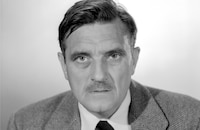Invaders from Mars

Brief Synopsis
Cast & Crew
William Cameron Menzies
Helena Carter
Arthur Franz
Jimmy Hunt
Leif Erickson
Hillary Brooke
Photos & Videos
Film Details
Technical Specs

Synopsis
Early one morning, young David MacLean, who loves science and astronomy, is awakened by a strange sound and sees a glowing, saucer-shaped object float down from the sky and bury itself in the sand pit behind his house. Frightened, David wakes up his mother Mary and father George, who is an engineer at a nearby scientific plant, and George, concerned by the usually level-headed David's hysteria, decides to investigate. Several hours later, while Mary prepares breakfast, she realizes that George has not returned and calls the police. Officers Jackson and Blaine answer her call, and when they search the sand pit, both are sucked below the sand's surface. Soon after, a glassy-eyed, perspiring George returns to the house. Mary and David are baffled by George's surly demeanor, and when David questions George about a small wound on the back of his neck, George uncharacteristically hits his son. The two policemen are also in an altered state when they appear suddenly, and soon after they leave, David spies on the area through his telescope and sees his neighbor, young Kathy Wilson, disappear into the ground. While George takes Mary to the sand pit, David dashes to the Wilson home, where he tells Mrs. Wilson that Kathy has disappeared. Mrs. Wilson is horrified, but Kathy suddenly arrives, although she, too, acts strangely. Mrs. Wilson is chastising David for scaring her when she smells smoke, and they discover that a fire has mysteriously started in the cellar. Kathy denies setting the blaze but smiles as David runs off. Eventually David goes to the police station, where he tells Chief Barrows his story. Barrows refuses to believe David and orders Sgt. Finley to detain him until his parents can collect him. The sympathetic sergeant calls in Dr. Pat Blake to examine the boy, and after ascertaining that Pat's neck is free from any injury, David tells her his story. Pat's curiosity is piqued, and when she sees how terrified David is by George and Mary's arrival, she tells them that he might be suffering from polio and is under her care. The couple reluctantly leave their son, and Pat takes him to see astronomer Stuart Kelston, a mutual friend. Stuart takes David seriously and informs them that prominent scientists have theorized that Martians, who live either underground on Mars or in giant spaceships, have manufactured synthetic humans called Mutax. Stuart speculates that Martians have come to Earth because George and Kathy's father, Dr. William Wilson, among others, have constructed a rocket that will eventually pave the way for a devastating weapon, both offensive and defensive, that could control the solar system. Stuart postulates that the Martians will attempt to destroy the rocket, and alerts Col. Fielding at a nearby military installation. Fielding notifies the Pentagon, and soon massive numbers of men and tanks begin to mobilize toward David's small town. Meanwhile, both Chief Barrows and Gen. Mayberry have been transformed by the Martians, and Stuart, Fielding, Pat and David question Turner, the Wilsons' next-door neighbor, about Kathy's sudden death. Concerned about the coroner's diagnosis of cerebral hemorrhage, Pat goes to the morgue to examine the body, while Capt. Roth, the military's electronics expert, speculates that the spaceship was able to tunnel underground with a radioactive ray that could melt the earth. Fielding's aide, Sgt. Rinaldi, foolishly explores the expanding sand pit and is sucked underground, after which Pat returns and shows the group a tiny device that was implanted at the base of Kathy's skull. Roth deduces that it is a controlling device, activated by high-frequency oscillation, and that when the human victims have carried out the Martians' orders, the device explodes, killing its host. Realizing the danger his parents are in, David grows depressed, especially when news arrives that Johnson and Blaine sabotaged the plant in which George works but died before they could be questioned. Mayberry and Barrows then attempt to blow up the rocket, but are killed by MPs before they can complete their mission, while George and Mary are captured during their attempt to assassinate Dr. Wilson. As they stand near the sand pit, Pat tells David that his parents have been rushed to the hospital and will soon be operated on, but suddenly they are sucked below ground by the Mutax, who have created a vast network of tunnels under the sand pit. Two of the Mutax take them to one of the Martians, an eerie being with a large head and a shrunken, tentacled body. The Martian, who communicates telepathically, questions Pat and David through Rinaldi, who explains that the Martian is "mankind developed to its ultimate intelligence." When Pat refuses to cooperate, the Mutax place her on an operating table in order to implant a control device in her neck, while Rinaldi carries off the struggling David. Above ground, Roth manages to locate the Martian's position, and the Army blasts an opening through to the tunnels. Led by Fielding and Stuart, the men find the spaceship and, battling the zombie-like Mutax, rescue Pat. The men then locate David and Rinaldi, while Fielding and Roth construct a bomb inside the spaceship. After setting the detonator for six minutes, they seal off the entrance to the spaceship with a grenade. Although the Mutax had similarly sealed off the group's escape route from the cave, David uses one of the ray guns to break through the rubble and soon they all scramble upwards. As David runs away, he remembers the events leading up to the blast, which rocks the earth as the spaceship tries to take off. The noise, which turns out to be a thunder and lightning storm, wakes up David, who had dreamed the whole adventure. David seeks comfort from his parents, who are perfectly normal, but after he returns to bed, he is once again awoken by a strange light in the sky as a spaceship lands behind the house.

Director

William Cameron Menzies
Cast
Helena Carter

Arthur Franz
Jimmy Hunt

Leif Erickson

Hillary Brooke

Morris Ankrum
Max Wagner
Bill Phipps

Milburn Stone
Janine Perreau
Charles Cane

Douglas Kennedy
Bert Freed
Todd Karns

Walter Sande

Robert Shayne

John Eldredge
William Forrest
Barbara Billingsley
Crew
Edward L. Alperson
Edward L. Alperson Jr.
Richard Blake
Eddie Boyle
Ben Chapman
Jack Cosgrove
Earl Crain Sr.
Ruby Felker
Gene Hibbs
Olive Konitz
Raoul Kraushaar
Leonard Kunody
Boris Leven
Gene Martin
William Cameron Menzies
Norma
Anatole Robbins
Arthur Roberts
John Seitz
Clifford D. Shank
Mary Yerke

Photo Collections
Film Details
Technical Specs

Quotes
Trivia
Originally designed for 3-D, but that plan was dropped just before shooting began.
The special effects department used condoms to create the "bubbles" on the walls of the underground tunnels.
John Seitz, the cinematographer, confirmed in a conversation with Wade Williams that Invaders From Mars was planned in great detail to be filmed in 3D. At the last minute, however, no camera was available. Nonetheless, all of the sets were constructed to be shot in 3D: this contributes to the unique look of the film. It is still possible that camera tests and stereoscopic still photographs may exist (though none have ever been found as of 2003) since newspaper advertisements announcing the film as "3D" were published while the film was still in pre-production.
Notes
William Cameron Menzies' onscreen credit reads: "Production Designed and Directed by." According to a September 25, 1952 Hollywood Reporter news item, John Archer was originally signed to play "Dr. Stuart Kelston." On October 7, 1952, Hollywood Reporter announced that dwarf actors Harry Monty, Billy Curtis, Buster Resmundi, Paul Klatt, George Spotts and Tommy Cotonaro had been cast in the picture, although a modern source states that they served as stand-ins. Modern sources also note that the film was originally scheduled to be shot in 3-D, but the plan was dropped before production began. As noted in a September 1, 1953 Hollywood Reporter news item, producer Edward L. Alperson decided to change the film's ending for foreign distribution. Feeling that "dream effects aren't too popular with foreign audiences, especially in Europe," Alperson decided to "add approximately eight minutes of scientific sequences" to the film and "alter [the end] so that viewers can use their own imagination." Shooting on the additional sequences, which were to be directed by Wesley Barry, began on September 2, 1953 at the KTTV Studios. According to modern sources, the European version eliminated the sequence of "David" waking up from his nightmare and instead ends in the observatory.
Modern sources add the following names to the crew credits: Screenplay John Tucker Battle and William Cameron Menzies ; Set constr Ralph Oberg; Opticals and mattes Jack Rabin and Irving Block; Asst makeup Steve Drum; Boom Earl Crain, Jr.; Electrial Jimmy Phillips and Paul Guerin; and Music Editor Richard Harris. According to one modern source, Battle was so upset by the film's dream ending that he demanded that his name be removed from the onscreen credits. Although one modern source credits Theodore Lydecker with additional special effects work, another source credits his brother, Howard Lydecker. Modern sources also add the following actors to the cast: Peter Brocco (Brainard), Frank Wilcox (Chief of Staff), Richard Deacon (Sentry Regan), Luce Potter (Martian), and Max Palmer and Lock Martin (Mutax). Invaders from Mars, which became a modern cult classic, was the last picture directed by noted production designer-director Menzies, who died on March 5, 1957. In 1986, Cannon Pictures produced a remake of Invaders from Mars, directed by Tobe Hooper and starring Karen Black, Hunter Carson, Timothy Bottoms and Laraine Newman. Jimmy Hunt, who played "David" in the 1953 version, appeared in the remake as the police chief.

Miscellaneous Notes
Released in United States March 1975
Released in United States Spring April 1953
Released in United States March 1975 (Shown at FILMEX: Los Angeles International Film Exposition (Science Fiction Movie Marathon - Selection of Trailers) March 13-26, 1975.)
Released in United States Spring April 1953











